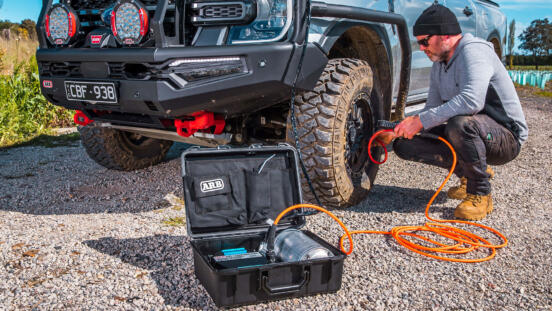
When exploring off-road, sooner or later you or a travel mate are going to get stuck, and require a snatch strap or winch recovery.
In high load recoveries, e.g. deep mud creating suction, inclines, etc. the forces on winch cables, extension straps, kinetic ropes, and recovery can be in excess of 2 tonnes (4,500lbs).
If one of these breaks, the recoiling line can become a deadly projectile.
Safe recovery practices dictate that no one should be near, or in line with a winch line or recovery strap while they’re under load. However, there is still the risk of vehicle damage and the potential for injury from unexpected deflection if someone accidentally wanders too close to a recovery in progress.
Steel winch cable retains a huge amount of energy when it snaps, and can cut like a blade as the recoiling line slices through the air. There is a misconception out there that dampeners are only required for steel cables because of this, but this is not the case. Synthetic ropes like Dyneema are safer due to retaining less energy when they break, as well as being softer, but they do still recoil with considerable force when snapped and can bring other objects with them.
Only rated recovery points should ever be used in a winching or snatch recovery, but these are not indestructible. A manufacturing fault, improper installation, or flaw in the material of a recovery point or its fasteners can lead to a failure. A 3kg (7lbs) steel recovery point tearing free during a recovery becomes a literal cannonball flying toward the opposite vehicle.
More than a few people have been killed in similar circumstances.

Image credit: Unknown
Above is a photo of an attempted recovery done incorrectly, using a tow ball instead of a rated recovery point, where the tow ball sheared off and was thrown into the driver of the vehicle. Sadly, incidents like this could have been avoided with some simple safety practices.
What does a rope dampener do, and how do you use it?
A rope dampener, also sometimes called a rope damper, or cable damper, is effectively a weighted blanket, which is placed at the middle point of a winch line or snatch strap (as pictured at the top of this article).
In the event a line snaps, the weight of the dampener absorbs some of the energy while bringing the recoiling line to the ground more quickly, slowing its speed, reducing its reach, and directing the recoiling line under the vehicle and away from its operator, reducing the chance of vehicle damage or injury.
A pair of dampeners can also be distributed along the line for additional safety.
Dampeners typically weigh around 2kg (5lbs) or more, though some brands do offer dampeners that weigh as little as a few hundred grams; in my experience, these lighter dampeners are just too light, and don’t do enough to mitigate the dangers of a recoiling line. I would suggest that 2kg+ is a minimum, and more is better.
Many dampeners also come with pockets, which can be loaded with sand, snatch blocks, or other heavy items for additional weight, to increase their effectiveness in bringing a snapped line to the ground swiftly.
Dampener alternatives
Dampeners are not specialty equipment and can be substituted with other items in a pinch. A tree drag chain or awning sandbag can serve as a replacement, or be added to the line as a second source of weight. Even multiple layers of beach towels or heavy blankets can do the job, as long as the combined weight is appropriate.
Just use something sturdy, not a collection of small items that could be dispersed, and use common sense in adding enough weight for it to be effective, e.g. the weight of a single towel is not going to be sufficient.
That said, purpose-made rope dampeners are cheap and durable. After your recoveries are concluded, just give your dampener a quick wipe down to remove any dirt or mud that will cause abrasion to it over time, and also to stop dirt from being brought into your vehicle, and it will last you countless trips.
Related topics:
How to use your winch – Winching mistakes to avoid.
How to perform a snatch recovery.





